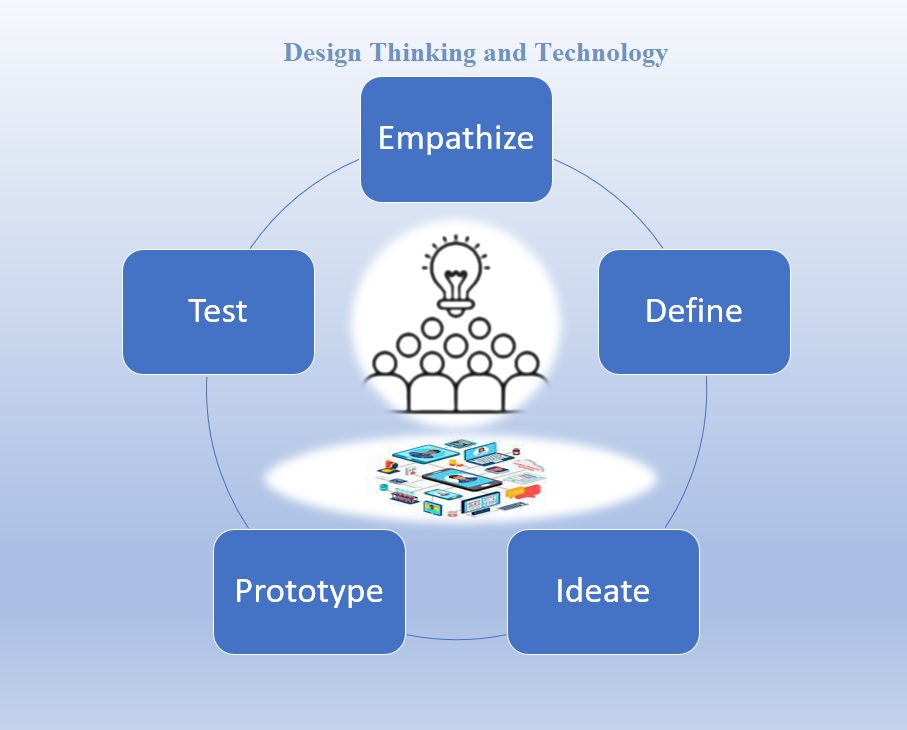
Markus and I often hear instructors talk about the challenges of fostering collaboration and critical thinking, especially when using technology. Therefore, a few years ago, we started to explore Design Thinking and how the Design Thinking model could be effectively used to support teaching data analytics and help students develop an analytical mindset.
Part I of this blog topic will focus on Design Thinking and the technology used to help students learn data analytics. Part II of the Design Thinking topic, presented in March, will expand upon how Design Thinking can use various technologies to support any learning environment.
So, let’s start by discussing what Design Thinking is and how it works. Design Thinking is a human-centered, creative problem-solving methodology that helps users address various real-world problems by discovering innovative solutions. Design Thinking helps students understand the importance of defining the actual issues rather than just problem symptoms. It provides students with the power of collaborative problem-solving and helps them learn through failure on the way to success. Additionally, Design Thinking helps develop collaboration and creativity skills, which are valuable in assisting students in developing an analytical mindset.
Design Thinking and data analytics work well together since both involve understanding the end-users needs, defining a problem, problem-solving through trial and error, analyzing data to identify solutions, and communicating recommendations or results. Since Design Thinking and data analytics both require students to develop an analytical mindset, they are a natural fit. Incorporating Design Thinking with Data Analytics reduces student reliance on memorization or rote learning. Instead, it helps learners develop flexibility, creativity, critical thinking, collaboration, and empathy skills. All of which are essential skills for the workplace.
The Design Thinking Model is comprised of five stages. (1) Empathize, (2) Define, (3) Ideate, (4) Prototype, and (5) Test.
The Empathize Phase connects the students to the end-users’ or stakeholders’ needs. Ideally, students can work with community partners on real-world projects, or they could work with simulated case studies. In the Empathize Phase, collaborative software (i.e., Zoom, Teams, etc.) can connect students with each other and with community partners. This discovery stage is where users of the model start researching and understanding the challenges stakeholders face and consider their needs. The goal of the Empathize Phase is to answer the following question: “What are the stakeholders trying to solve?”
The Define Phase is where students identify the problem. This phase is one of the most challenging phases of the Design Thinking process for students. Too often, students define a symptom of the problem rather than the problem itself. Students quickly learn that if they define the wrong problem, they will spend time looking for the wrong solutions. Design Thinking helps students focus on the importance of identifying the real issues in order to appropriately suggest solutions.
The next phase is the Ideate Phase. During this phase of Design Thinking, brainstorming occurs. Students think about various approaches to solve the defined problems. They need to generate as many ideas as possible and not eliminate anything at this point. By the end of this phase, students can start narrowing down their ideas into options that can be acted on. Technology like Evernote, OneNote, Padlet, Trello, Popplet are great tools for students to use during this phase. These tools can help students collaborate during brainstorming and as they narrow down their ideas to the best solution.
Step four in the Design Thinking process is the Prototype Phase. For organizations looking at products or services, this phase creates something. For student projects, this phase is where ideas get converted into real solutions. During this phase, students also start to understand that they can learn by failure on the way to success.
The final phase in Design Thinking is the Test Phase. The Test Phase allows students to check their work and determine the effectiveness of their proposed solutions. During this phase, bringing in outside reviewers can be helpful. When students work with a community partner, the community partner will act as the outside reviewer. Data analytics technology tools utilized during the Test Phase can be Tableau, PowerBI, Excel, or other analytical software that creates visualizations. This phase of Design Thinking lets students test their ideas and get feedback from others. Students also use reflection at this stage as they decide what’s next.
To read more about what Markus and I are doing with the Design Thinking Model and Data Analytics, click on the following link to the AICPA Extra Credit article, A road map for learning data analytics, Models can help faculty teach – and students grasp – this important subject. (Meyer, C., 2021) https://www.journalofaccountancy.com/newsletters/extra-credit/road-map-learning-data-analytics.html
Our March 2023 blog will be Part II of this series. We will introduce more technologies to use with various learning activities and each phase of the Design Thinking process.
2023 Teaching and Learning Toolbox










You must be logged in to post a comment.